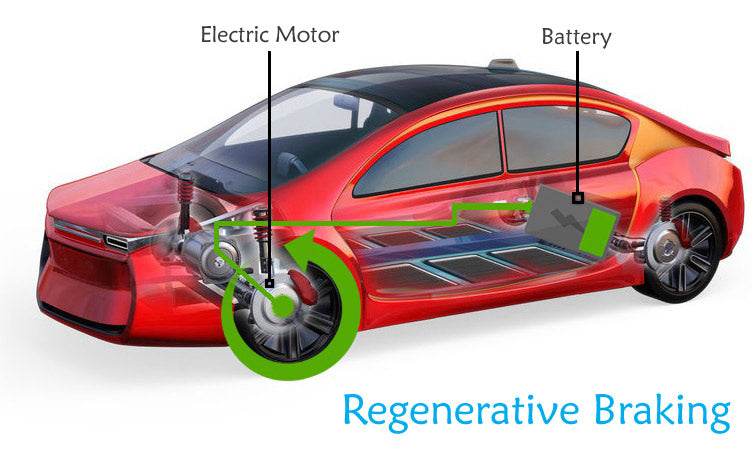Regenerative braking was invented back in the sixties and Toyota was the first automanufacturer to use it in the hybrid Prius EV. Tesla has taken massive advantage of this technology that makes it one of their best features.
Hybrid and electric vehicles use battery technology, aerodynamics, and other mechanical advancements to achieve driving efficiency. Regenerative braking is one such characteristic used by these energy-efficient vehicles. Regenerative braking helps to recharge the battery by using energy that would otherwise be lost when stopping a car.
How does Regenerative Braking work?
When you press the brake pedal in a gas-powered car, friction is produced as the brake discs and brake pads come into contact. Friction then generates kinetic energy, which is released into the environment as heat.
Regenerative braking allows for the recovery and conversion of kinetic energy, which would otherwise be transformed to heat. In this system, when moving forwards or cruising, the engine propels the wheels, and when slowing down, the wheels propel the motor. The engine actually works like a generator by recharging the vehicle's battery thanks to this two-way energy flow.
Regeneration can happen under two circumstances:
- After pressing the brake pedal
- When the driver lets off the gas pedal when the car is coasting

Image credit: Circuit Insider
The mechanism generates electricity in both scenarios to recharge the battery. Drivers may see this regenerative effect on the car's charge indicator, which shows it as energy going from the wheels to the battery. The electrical current increases as the braking force does. The system's ability to capture energy ultimately depends on the vehicle's speed and how long the brakes are applied for.
When braking, the technology automatically divides the braking force between the conventional brake system and energy regeneration. And so, the technology works to slow the car down and at the same time, recharge the battery to increase the car's economy and electric driving range.
The efficiency of Regenerative Braking
New hybrid or electric vehicle models are released every year with more advanced regenerative braking systems, increasing the amount of energy these systems can store. The most recent regenerative braking technologies can sometimes recover up to 70% of the kinetic energy that would otherwise be wasted while braking.
This can result in hundreds more miles of electric range every year, depending on how often the owner uses their car. It lessens the requirement for pure EVs to plug into the electrical grid and decreases the number of journeys to the gas station for hybrids.
Many more recent regenerative braking systems outperform older ones, feel more natural to the driver, and provide the same degree of effectiveness as traditional systems. Be sure to pay great attention to how the brakes feel and function when test-driving hybrid and electric automobiles. The difference might not even be noticeable to you.
Regenerative braking is a key factor in the overall efficiency equation for hybrid and electric vehicles, which is achieved through the integration of multiple technologies. Due to their low wear and tear characteristics, regenerative braking systems also increase electric range while reducing energy loss and extending brake life.
Tesla’s Magical Regen Braking
Tesla addressed a problem in an update (2022.16) in May of this year that added a setting that would allow the vehicle to function as well with or without regenerative braking. The vehicle will automatically apply its normal brakes when regenerative braking is reduced, and the driver releases the accelerator pedal. This ensures that the driving experience is constant regardless of how much regenerative braking is available.
One of the most important elements that contributes to how efficient electric vehicles are is regenerative braking. The majority of EVs will slow down when in motion even though the brakes are not used if the driver eases off on the accelerator or lifts their foot almost off the pedal to decelerate.
This one-foot driving technique reduces the need for brake pads and recharges the battery, producing more energy. Tesla made the strongest regenerative braking mode standard in 2020 because it considers it to be such a crucial feature.
When the automobile is fully charged, the battery won't require any additional power. In frigid climates, this system has also been observed to behave differently. But the update in May fixed that!
* Tesla features may differ depending on model and country availability.









